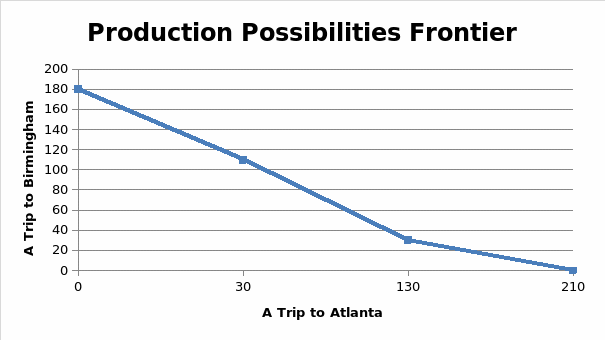Introduction
Supply, demand, and price are among the fundamental economic terms. This essay discusses some of the aspects in which the suppliers and consumers shape the price, the effects narrow and wide price dispersion has on both parties and the role of the cost as a transmitter of information. The paper employs two planned two-day holidays attached in the form of a Production Possibilities Frontier in Appendix A as an example.
Main body
In planning a trip, it can be reasonably easy to browse the Airbnb website, which offers numerous options in one place. When checking the accommodation prices, one can find they all vary by a couple of dollars. Therefore, the price dispersion on the site seems relatively low at first sight. Reportedly, in traditional commerce, the difference between the maximum and minimum price for a good is high because the primary strategy is price discrimination or pricing differs depending on the target audience (Kim et al., 2020). Moreover, researchers find that suppliers can incorporate several strategies to maintain cost diversity on online platforms (Kim et al., 2020). However, it does not mean that price dispersion is necessary or desirable.
As much as the sellers have tools to evaluate the specifics of their customers, the buyers can also quickly gauge the market utilizing a basic internet search. Scholars suggest that a wide price dispersion makes people uncertain and uncomfortable (Kim et al., 2020). To mitigate the adverse effects of these feelings, sellers can cater the offers to individuals. Yet, when a customer purchases a good or service for the first time, he or she does not have a previous price to reference in evaluating the expected expenditure. Therefore, online travel agents such as Airbnb assist with the estimation by showing averagely priced commodities (Kim et al., 2020). Narrow price dispersion allows consumers to make decisions with less effort (Kim et al., 2020). In such a context, the price serves as an informational clue, while in situations of low uncertainty and wide dispersion, people view the cost as an estimate of how much they lose (Kim et al.). Overall, price dispersion has psychological effects on the buyers, and the smaller it is, the more pleasant their feelings are.
Another aspect that illustrates how price serves as a transmitter of information is an indication of premium goods and services. However, the information presented by a premium package is misleading to the consumer. It leads him or her to an exaggerated view of potential losses (Chark et al., 2019). Therefore, presenting an overpriced premium package as a source of information for the customer to consider may benefit the seller and disadvantage the buyer.
Apart from that, the price can be a genuine information cue for a consumer. It can create expectations of future experiences (Schmidt et al., 2017). Based on how expensive a product or a service is from the buyer’s perspective, he or she may imagine its quality and the level of enjoyment it brings (Schmidt et al., 2017). Therefore, not only does the price serve as a point of comparison and create illusory certainty, but it may also allow the traveler to build expectations of his or her future hotel stay and evaluate its desirability. It is possible that the initial impressions the customer received upon learning the price will impact his or her impressions upon using the good or service.
Conclusion
To conclude, price is a fundamental information clue for the buyers. It is simpler for buyers to compare prices than other characteristics of similar products. It can also benefit the sellers, who can acquire information about their customers and the costs of the competitors to develop a strategy maximizing their gains. Sometimes it can be misleading when the suppliers manipulate consumer’s emotions to sell their goods. It can also shape, to an extent, the customer’s experience with the product.
References
Chark, R., Mak, V., & Muthukrishnan, A. V. (2019). The premium as informational cue in insurance decision making. Theory and Decision, 88(3), 369–404 Web.
Kim, J., Franklin, D., Phillips, M., & Hwang, E. (2020). Online travel agency price presentation: examining the influence of price dispersion on travelers’ hotel preference. Journal of Travel Research, 59(4), 704-721. Web.
Schmidt, L., Skvortsova, V., Kullen, C., Weber, B., & Plassmann, H. (2017). How context alters value: Price information recruits the brain’s valuation and affective regulation system for shaping experienced taste pleasantness. Scientific Reports 7(1). Web.
Appendix A
Production Possibilities Frontier
